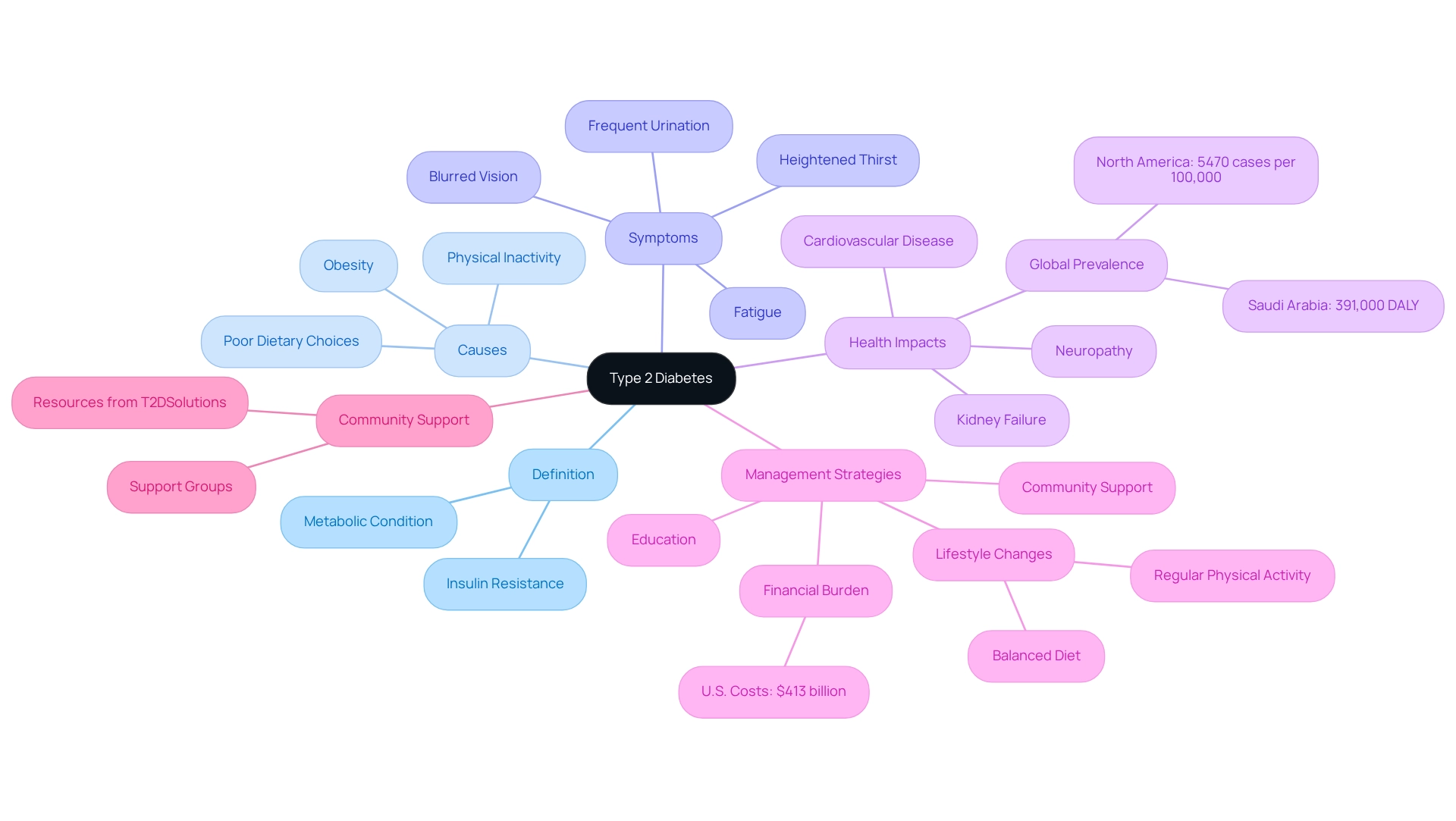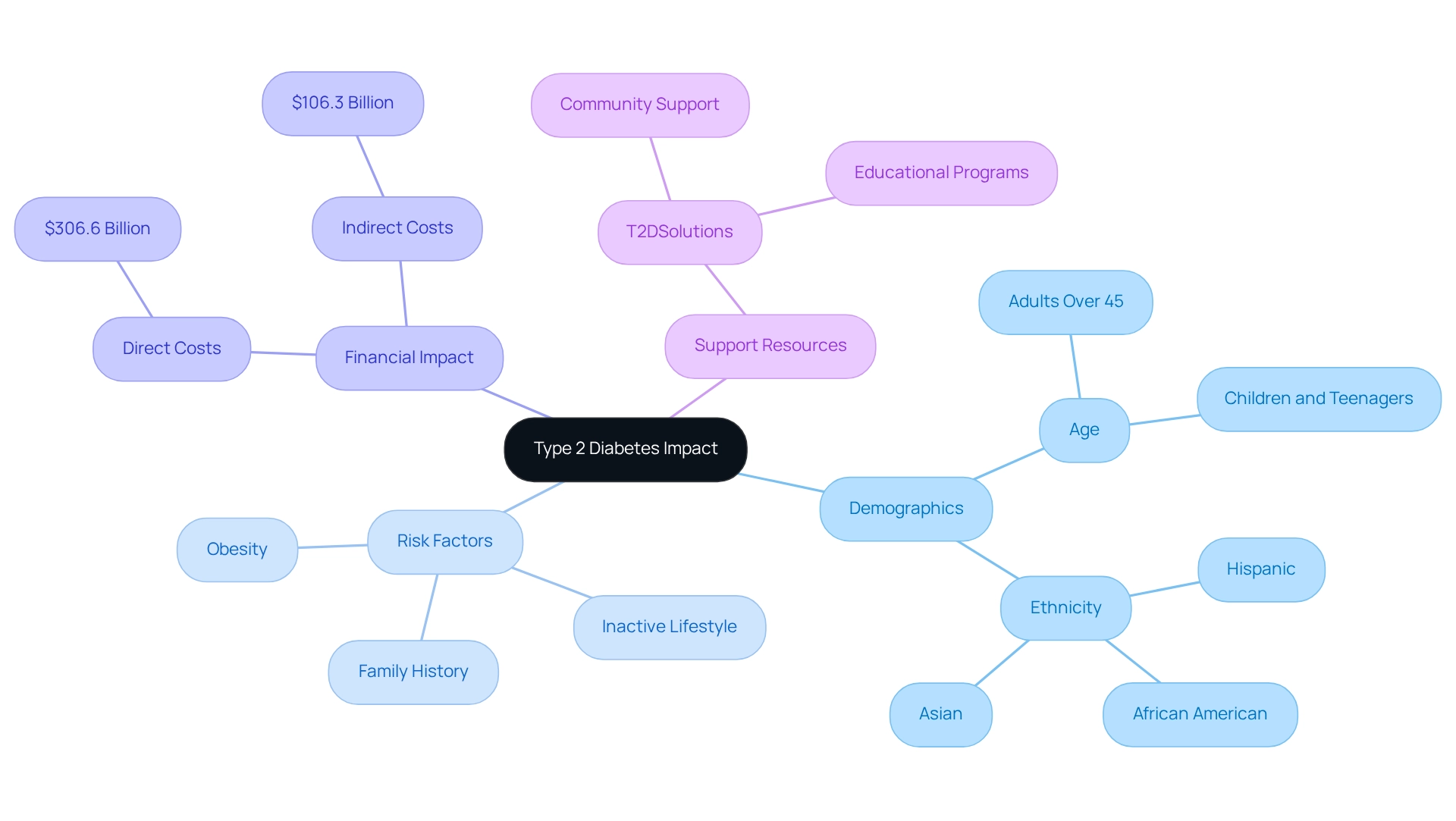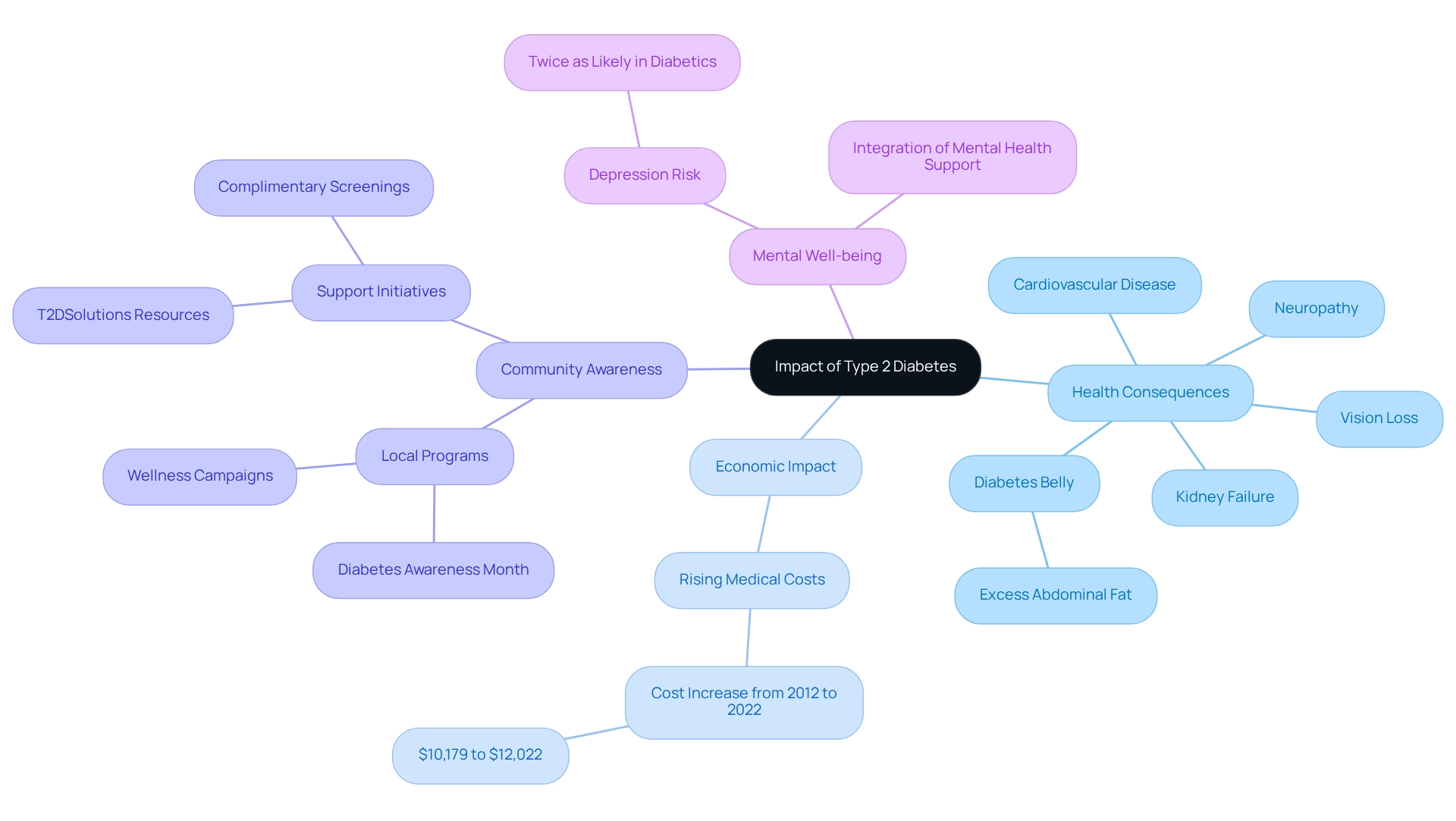Overview
Type 2 diabetes primarily affects adults, especially those over 45 years old, but it's concerning to see its prevalence alarmingly increasing among younger populations, including children and teenagers. Approximately 11.1% of the global adult population is affected, and significant risk factors such as obesity and a sedentary lifestyle are at play.
It's understandable to feel worried about this growing health crisis. We must emphasize the need for targeted interventions and community support to address these challenges together. Remember, you're not alone in this journey; we are here to support you every step of the way.
Introduction
Type 2 Diabetes is more than just a health condition; it represents a growing public health crisis that affects millions globally. It’s understandable to feel concerned about this chronic disorder, characterized by insulin resistance and rising blood glucose levels. This condition is intricately linked to lifestyle choices and demographic factors, and as its prevalence continues to soar, understanding its implications becomes crucial—not only for those diagnosed but also for families and communities at large.
The economic burdens and severe health complications associated with Type 2 Diabetes are significant, making the urgency for effective management and education paramount.
In this article, we will delve into the complexities of Type 2 Diabetes, exploring:
- Who is at risk
- The health consequences of the disease
- The vital role community awareness plays in combating this escalating epidemic
Remember, you’re not alone in this journey; we are here to support you every step of the way.
Define Type 2 Diabetes: Understanding the Condition
Type 2 diabetes is a long-lasting metabolic condition characterized by insulin resistance, where the body does not use insulin efficiently, leading to increased blood glucose levels. This condition often develops gradually and is frequently linked to lifestyle factors such as obesity, physical inactivity, and poor dietary choices. Symptoms associated with Type 2 diabetes include heightened thirst, frequent urination, fatigue, and blurred vision.
At T2DSolutions, we understand how crucial it is to comprehend Type 2 diabetes. This condition raises concerns about who does type 2 diabetes affect, as it impacts millions around the world and can lead to serious health issues, including cardiovascular disease, kidney failure, and neuropathy if not managed properly. Our mission is to provide comprehensive resources and community support to empower individuals in managing their condition.
Recent studies highlight that the global prevalence of this chronic illness continues to rise, posing significant challenges for public health. For example, in high-income North America, the prevalence rate is approximately 5,470 cases per 100,000 individuals. In Saudi Arabia, the disability-adjusted life years (DALY) associated with the condition reached 391,000, emphasizing its impact on quality of life and raising the question of who does type 2 diabetes affect. Understanding Type 2 diabetes is vital, and T2DSolutions is here to help individuals through education, lifestyle changes, and community involvement. This approach is essential, as noted by D Trico, who emphasizes the importance of funding for diabetes-related research and management initiatives.
Real-life examples of successful lifestyle changes—such as adopting a balanced diet rich in whole foods, engaging in regular physical activity, and participating in community support groups—demonstrate how individuals can proactively manage their condition. Furthermore, the financial burden of this illness is substantial; a case study revealed that the total direct and indirect estimated costs of diagnosed cases in the United States in 2022 was $413 billion. This underscores the need for effective management strategies to reduce healthcare costs and improve patient outcomes.
As research continues to evolve, it’s essential to stay informed about the latest findings on insulin resistance and its relationship with this condition for effective management and prevention strategies. T2DSolutions is committed to being a valuable resource on this journey. Remember, you're not alone in this journey; we are here to support you every step of the way.

Identify Who is Affected by Type 2 Diabetes: Demographics and Risk Factors
Condition 2 primarily affects adults, especially those over 45 years of age, and raises the question of who does type 2 diabetes affect. However, it's concerning to see who does type 2 diabetes affect, as its occurrence is alarmingly increasing among younger groups, including children and teenagers. Current estimates suggest that roughly 11.1% of the worldwide adult population is affected by this condition, with the second form contributing 90-95% of these instances.
The financial strain of this condition in the U.S. reached a staggering $412.9 billion in 2022, with $306.6 billion linked to direct medical expenses and $106.3 billion to indirect costs. This highlights the considerable effect of this illness on healthcare systems and individuals alike, particularly addressing who does type 2 diabetes affect, with key risk factors including obesity, an inactive lifestyle, and a family history of the illness.
It's important to understand who does type 2 diabetes affect, as certain ethnic groups, including Hispanic, African American, and Asian populations, show a greater vulnerability to developing this form of the disease. For instance, recent studies indicate that individuals over 45 years old account for a significant portion of diagnosed cases, emphasizing the necessity for focused interventions in this demographic to better understand who does type 2 diabetes affect as we deepen our understanding of diabetes epidemiology.
G.S.B., the guarantor of this work, emphasizes the integrity and accuracy of the data analysis, reinforcing the reliability of these findings. Real-life instances demonstrate who does type 2 diabetes affect, highlighting that even teenagers are increasingly diagnosed with this condition, which prompts a reassessment of public wellness strategies to tackle this rising issue.
By acknowledging these demographics and risk factors, healthcare providers can more effectively customize educational programs and preventive strategies to address the increasing prevalence of type 2 diabetes. Remember, you're not alone in this journey. T2DSolutions aims to support newly diagnosed patients by providing essential resources and community support to help them understand and manage their condition effectively. We are here to support you every step of the way.

Examine the Impact of Type 2 Diabetes: Health Consequences and Community Awareness
The consequences of Type 2 Diabetes raise the question of who does type 2 diabetes affect, extending far beyond personal wellness and deeply impacting families and communities. Complications related to this condition—such as cardiovascular disease, kidney failure, neuropathy, and vision loss—can significantly diminish one's quality of life. It's understandable to feel concerned when considering that recent findings show 8.0% of adults with diagnosed blood sugar conditions have non-HDL cholesterol levels of 190 mg/dL or higher. This statistic highlights the serious health risks associated with the illness.
Economically, managing Type 2 Diabetes can be a heavy burden. The excess medical costs per person surged from $10,179 in 2012 to $12,022 in 2022, placing immense strain on our healthcare systems. This rise in expenses underscores the broader economic impact, emphasizing the need for a united approach to effectively manage the condition. Community leaders stress the importance of raising awareness and providing resources to tackle diabetes-related issues. For instance, the Centers for Disease Control reports that 26.4 million individuals aged 65 years or older (48.8%) have prediabetes.
Community awareness programs, such as Diabetes Awareness Month and local wellness campaigns, play a vital role in informing the public about prevention and management strategies. T2DSolutions is dedicated to empowering individuals and families by offering comprehensive management resources and fostering community support. Local wellness events frequently provide complimentary screenings and informative resources, creating a supportive atmosphere that helps reduce the stigma surrounding blood sugar conditions.
Additionally, understanding the concept of 'diabetes belly,' which refers to excess abdominal fat, is crucial as it may increase the risk of developing complications. Furthermore, it's important to recognize that individuals with diabetes are twice as likely to experience depression compared to those without the condition. This emphasizes the necessity of incorporating mental well-being support into diabetes management, particularly for understanding who does type 2 diabetes affect, as addressing both the health consequences and the economic implications of Type 2 Diabetes allows T2DSolutions and community initiatives to play a pivotal role in improving outcomes for those affected. Remember, you're not alone in this journey; we are here to support you every step of the way.

Conclusion
Type 2 Diabetes presents a complex challenge, not just for those diagnosed but also for families and communities grappling with its widespread implications. Understanding this chronic condition is crucial—from its definition and risk factors to its profound health consequences and economic burdens. With the prevalence of Type 2 Diabetes on the rise, particularly among younger populations, recognizing who is affected and the lifestyle choices that contribute to its development is essential.
The health risks associated with Type 2 Diabetes are significant, ranging from cardiovascular disease to kidney failure. This emphasizes the urgent need for effective management strategies. The economic impact is equally alarming, with billions in healthcare costs attributed to diabetes management. It highlights the necessity for community awareness and education. Initiatives like Diabetes Awareness Month serve as vital platforms to inform the public and foster supportive environments for those affected.
Ultimately, addressing Type 2 Diabetes requires a collective effort that encompasses education, lifestyle changes, and community support. Organizations like T2DSolutions play a pivotal role in providing resources and fostering a sense of community among those navigating this condition. By prioritizing awareness and proactive management, we can combat the rising tide of Type 2 Diabetes and improve health outcomes for individuals and society as a whole.
The journey may be challenging, but with the right support and information, it is one that can lead to better health and quality of life. Remember, you're not alone in this journey. We are here to support you every step of the way.
Frequently Asked Questions
What is Type 2 diabetes?
Type 2 diabetes is a long-lasting metabolic condition characterized by insulin resistance, where the body does not use insulin efficiently, leading to increased blood glucose levels.
What are the common causes of Type 2 diabetes?
Type 2 diabetes often develops gradually and is frequently linked to lifestyle factors such as obesity, physical inactivity, and poor dietary choices.
What are the symptoms of Type 2 diabetes?
Symptoms associated with Type 2 diabetes include heightened thirst, frequent urination, fatigue, and blurred vision.
How many people are affected by Type 2 diabetes globally?
Type 2 diabetes impacts millions of people around the world, with a significant prevalence rate, particularly in high-income regions like North America.
What serious health issues can arise from unmanaged Type 2 diabetes?
If not managed properly, Type 2 diabetes can lead to serious health issues, including cardiovascular disease, kidney failure, and neuropathy.
What is T2DSolutions and how can it help individuals with Type 2 diabetes?
T2DSolutions provides comprehensive resources and community support to empower individuals in managing their condition through education, lifestyle changes, and community involvement.
What recent statistics highlight the prevalence of Type 2 diabetes?
In high-income North America, the prevalence rate is approximately 5,470 cases per 100,000 individuals. In Saudi Arabia, the disability-adjusted life years (DALY) associated with the condition reached 391,000.
What lifestyle changes can help manage Type 2 diabetes?
Successful lifestyle changes include adopting a balanced diet rich in whole foods, engaging in regular physical activity, and participating in community support groups.
What is the financial burden of Type 2 diabetes in the United States?
A case study revealed that the total direct and indirect estimated costs of diagnosed cases in the United States in 2022 was $413 billion.
Why is it important to stay informed about Type 2 diabetes?
Staying informed about the latest findings on insulin resistance and its relationship with Type 2 diabetes is essential for effective management and prevention strategies.



